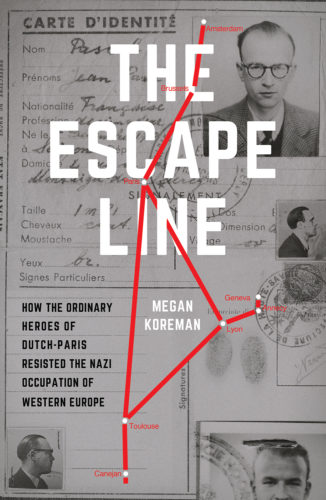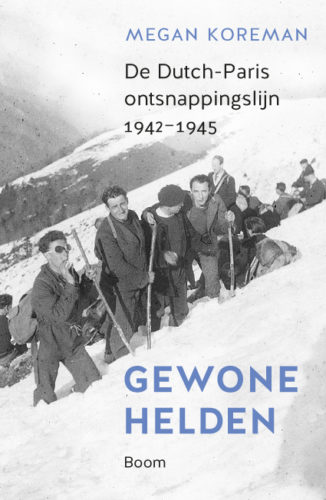Searching for the Dutch-Paris Escape Line
Reasons for False Claims of Resistance Affiliations
Following the last few posts, I have one last comment about resisters being identified with a resistance group that did not officially acknowledge them.
In most cases there are only two reasons for a resister’s resistance group of network to be misidentified. It’s either an innocent mistake or something altogether darker.
Innocent mistakes happened because during the war resisters generally didn’t have a name for their organization beyond the generic “organisatie” or a code name that only they and their immediate colleagues used. That’s just basic security. Dutch-Paris, for example, was a name used by British military intelligence and adopted after the war because it was most likely to get assistance for resisters who’d been impoverished and needed medical help after arrest and deportation.
For example, a woman who worked for Dutch-Paris survived the war but none of the people she knew and worked with during the war did. She returned home and was asked to fill out forms to claim her resistance benefits. She honestly did not know what Read the rest of this entry »
How the Official Resistance Lists were Compiled
The last post about Josette Molland brings up the interesting question of how an individual ended up belonging to a particular resistance group in the postwar documents that now constitute the documents that historians use to write the history of the war.
This is a different question than how someone joined a resistance group during the war. That was a matter of timing and opportunity. The question of how someone is categorized in the documents is more a question of codification and administration.
The answer actually varies by archive because every archive was compiled by an agency with its own mission. The Dutch Red Cross, for example, interviewed everyone who returned to the Netherlands after the war but not everyone who stayed in the country during the war. The US archives gathered information about resisters who helped downed American airmen but nothing about resisters who worked on underground newspapers in France.
The difficulty for every agency, whether it was the French army or the Red Cross, was that resistance was Read the rest of this entry »
Josette Molland
Here’s an example of the sort of confusion about who worked with what resistance group that I’ve been discussing in the last few posts.
On 8 March 2024, The New York Times ran a front page obituary about Josette Molland, a French resister who survived the concentration camps and made a point of sharing her experiences through paintings and talks. The article identifies her as “fabricating false papers and transporting them for the famed Dutch-Paris underground network…”
There is absolutely no question of Ms Molland’s illegal work. She earned every one of those Resistance medals that she is wearing in an accompanying photograph. But she was not, technically, a member of Dutch-Paris. In fact, the chef de reseau of Dutch-Paris was quite adamant in several official documents that she was not part of Dutch-Paris. She is, instead, registered in the official French records at the Service historique de la défense, Bureau Resistance, as a member of Read the rest of this entry »
Why Dutch-Paris is so Famous : Publicity
Let’s continue our discussion of why many people assume that anyone who made it from the Netherlands to Spain or Switzerland during the war did so with the help of Dutch-Paris. The simple answer is that Dutch-Paris is the most well-known civilian escape line in western Europe. I say civilian to distinguish it from lines like Comet that were supported by the Allied secret services such as the British SOE or the American OSS. Those line specialized in helping servicemen, particularly aviators, whereas Dutch-Paris helped anyone who needed it.
But it’s crucial to this story that a small percentage of the fugitives who Dutch-Paris helped were Allied aviators. Both the Americans and the British put considerable effort into recognizing the civilians who helped their servicemen during the occupation, which created a lot of very useful documentation and also a certain buzz. In addition to that the leader of Dutch-Paris, John Weidner, and some of his colleagues from the line, were commissioned into the Dutch Army after the liberation with the task of Read the rest of this entry »
Why Dutch-Paris is so Famous : Politics
In the last post we discussed the localized fragmentation of the resistance and how there were many different rescue groups that helped fugitives get away from the Nazis. So why is it that so many people assume that if someone got from the Netherlands to Switzerland or Spain during the war they must have been helped by Dutch-Paris?
Mostly, it has to do with politics and publicity or fame. Let’s look at the politics first.
At the end of the Second World War the Soviet Union had essentially occupied Eastern Europe. For their part, Western European governments were worried about Communists taking over their own countries through the ballot box or by force as well as the possible intentions of the American Army to impose occupation governments. We’ll just focus on Western Europe in this post.
The Western European governments obviously wanted to Read the rest of this entry »
Dutch-Paris was Not the only Escape Line
Despite the common term “the Resistance” and the claims of politicians like Charles de Gaulle, the civilian resistance against Nazi occupation during the Second World War was not monolithic. It wasn’t even the work of a few large, well-known national networks. For the most part resistance was the highly fragmented and localized work of discrete groups of people who saw a need and acted on it.
This is especially true for rescue work and escape lines. In fact, there were many rescuers of Jews who worked entirely independently without ever belonging to an organized group of any sort. You could do that if you were hiding someone. But you could not act entirely alone if you wanted to move that someone to a place of greater safety. That required cooperation among a few people but not necessarily very many people.
A lot of rescue groups/escape lines operated in very specific areas, most often on a border. There were, for example, small groups that Read the rest of this entry »
Essential Qualities of Resistance Leaders – Imagination
We’ve been discussing the essential qualities of a resistance leader, including being a good judge of character, having social skills, and being decisive, flexible and steady. Perhaps the most essential of all, however, the quality that would get a man or a woman into the predicament of leading a resistance group in the first place, is imagination.
Perhaps I should qualify that as compassionate imagination. Lots of people were able to imagine the consequences of Nazi rule, the dissolution of personal liberties, the terror. But very few people became resistance leaders. Seeing what’s happening around you and imagining how it could get worse is one thing. Imagining a way out of it is another. And imagining that risking your life in order to publish a clandestine newspaper or rescue strangers would be a way to free everyone from Nazism takes Read the rest of this entry »
80th Anniversary of the Liberation of Maastricht
Eighty years after the American Army liberated his hometown of Maastricht on September 13-14, 1944, my father still remembers the day. This is his story of his liberation.
Only six years old, he lived with his parents and older sisters in a small petit bourgeois home in the neighborhood of Wyck, east of the River Maas (aka Meuse). The old St. Servaas Bridge leads from the heart of the city to Wyck and the train station. The Germans had laid dynamite along the bridge but were also using it as an escape route from the Allies, who had liberated Brussels ten days earlier.
The people of Maastricht could anticipate their liberation with mixed feelings. Obviously they wanted to be free of the Nazi occupation, but the process was worrisome. They could end up in a battleground and had, indeed, already suffered deaths from Allied bombers who mistook their target. The German Army or the Nazis could decide to make an example of them or take reprisals for some act of resistance out on them. Horrible stories were circulating and not all of them were only rumors.
So my grandparents kept their young son inside. The entire neighborhood was inside, waiting quietly so as not to attract any attention from trigger-happy or vengeful troops. They could hear the noise of war to the south and east. Then they heard a tank clattering up a street. Tanks make a tremendous amount of noise on a cobbled street when no civilian has been able to drive an automobile for years. The brave peeked out the window.
No one recognized this tank. They were sadly familiar with the SS and the Wehrmacht and their armament. It wasn’t one of theirs, but it could belong to an as yet unknown German unit.
The tank stopped at a crossroads. Its gun turret swung around. The hatch opened.
A soldier unfolded himself out of the turret. He struck a match and lit a cigarette.
People immediately ran out of their homes to greet their liberators. Some carried bottles of alcohol they’d been saving for this very day for years. How did they know that this tank belonged to the Allies and had come to liberate them? Because no German soldier would ever smoke on duty like that.
Many others things happened in the city of Maastricht that day. Some families were bereaved, many were jubilant. But that’s what one six-year-old boy remembered of his liberation from Nazi occupation.
Qualities of a Resistance Leader – Steadiness
Here’s another essential quality in a resistance leader: courage, or holding steady through anxiety.
Resisters knew they had a lot to fear. By the end of the war the occupation authorities followed a policy of ruling the population through terror. To that end they took hostages from among the civilian community and publicly executed them when German soldiers were assassinated. They made no secret of the fact that they tortured men and women. They did not hide that they deported political prisoners to camps in the Third Reich, although they did hide what exactly happened in those camps to make them more frightening.
Resisters were afraid, if not for themselves then for their families. But they Read the rest of this entry »
Qualities of a Resistance Leader – Flexibility
We’ve been discussing the necessary qualities of a resistance leader, or, really, any resister who intended to survive the war. You needed to be a good judge of character, good at making friends and able to act decisively. You also had to be flexible.
Actually, any civilian needed a certain flexibility of mind and attitude to navigate the Nazi occupation. I don’t mean the sort of moral flexibility that would allow someone to justify turning a blind eye to some glaring injustices, although that did happen. I’m referring to a much more practical flexibility in day to day life. For example, putting enough food on the table. There were a few French civil servants who refused to accept any food from any source other than the official rations. They and their families ended up Read the rest of this entry »

